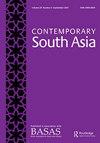Un/common schooling: educational experiments in twentieth-century India
IF 0.8
3区 社会学
Q3 AREA STUDIES
引用次数: 0
Abstract
changes associated with the Kali Yuga. It is not just limited to economic and environmental conditions, but the fear of contagion and other gendered stigmas profoundly affect their social standing, which is only worsened by notions of morality reinforced by public health camps. As opposed to the disclosure of diagnosis to patients, withholding the truth from them was considered an act of care by many patients. The loss of body parts such as breasts, uterus and hair as a result of radiation comes not just with immense physical and mental pain but also various exclusions (especially in the economic and sexual realm) with the stigma attached to it. Van Hollen’s ethnographic inquiry exposes the deeply intertwined nature of biomedical interventions and spiritual healing as several of these women simultaneously reached out to Samiyars – intermediaries between Gods and humankind – and the Pentecostal church in addition to the biomedical treatment they received. Emphasizing the structural violence faced by these women, Van Hollen concludes that healthcare initiatives do not account for their concerns for care and causality. Van Hollen’s work is extremely significant in the realm of medical anthropology as it vividly delineates the experience of these specific cancer patients whilst also offering a multidimensional understanding. It is empirically grounded and brings out the nuances of everyday lived experiences. While Van Hollen clearly deconstructs notions of morality embedded in public health campaigns, it would have been useful to dig deeper, in order to acknowledge the colonial residues inherent in the discourse, as evident in anti-abortion arguments and the emphasis on hygiene, sterilization and monogamous sex. In other words, it is crucial to observe the historical continuities through which Victorian morality is still reflected in our healthcare attitudes and conceptions, especially in stateled healthcare. In addition, although Van Hollen captures an extensive field view of cancer and suffering, her subaltern critique does not rise to posit a critique of the biomedical model in itself, as Arthur Kleinman has demonstrated in The Illness Narratives: Suffering, Healing and the Human Condition (Basic Books, 1988). As she rightly points out, the public health discourse neither accommodates people’s beliefs in spiritual modalities of healing nor considers their socio-economic conditions. However, it is also vital to take a step further to argue that the rational, scientific and medico-legal vocabulary of biomedicine is intrinsic to public health discourse. More importantly, the critique of biomedicine as a system needs to be foregrounded, as it establishes itself as a distinct paradigm on a higher pedestal, through which the healing process becomes increasingly depersonalized and unidimensional. Nevertheless, her work offers a remarkable reading experience and hence, is highly recommended for medical anthropologists.非公立学校:20世纪印度的教育实验
与卡利尤加相关的变化。这不仅限于经济和环境条件,对传染病的恐惧和其他性别污名深刻影响了他们的社会地位,而公共卫生营强化的道德观念只会使他们的社会状况恶化。与向患者披露诊断相反,许多患者认为隐瞒真相是一种照顾行为。辐射造成的乳房、子宫和头发等身体部位的损失不仅带来巨大的身心痛苦,还带来各种排斥(尤其是在经济和性领域),并带来耻辱。Van Hollen的民族志调查揭示了生物医学干预和精神治疗的深刻交织性质,因为这些女性中的一些人除了接受生物医学治疗外,还同时接触了神与人类之间的中间人Samiyars和五旬节教会。Van Hollen强调了这些妇女面临的结构性暴力,他得出结论,医疗保健举措没有考虑到她们对护理和因果关系的担忧。Van Hollen的工作在医学人类学领域具有极其重要的意义,因为它生动地描绘了这些特定癌症患者的经历,同时也提供了多层面的理解。它以经验为基础,展现了日常生活经历的细微差别。虽然范霍伦显然解构了公共卫生运动中的道德观念,但更深入地挖掘,以承认话语中固有的殖民残余,这在反堕胎的论点和对卫生、绝育和一夫一妻制性行为的强调中是显而易见的。换言之,观察维多利亚时代的道德仍然反映在我们的医疗保健态度和观念中的历史连续性,尤其是在国家医疗保健中,这一点至关重要。此外,尽管Van Hollen对癌症和痛苦有着广泛的视野,但她的下层批判并没有像Arthur Kleinman在《疾病叙述:痛苦、治愈和人类状况》(the Disease Narratives:Painting,Healing and the Human Condition)(基础书籍,1988)中所展示的那样,对生物医学模式本身提出批判。正如她正确指出的那样,公共卫生话语既没有考虑到人们对治愈精神模式的信仰,也没有考虑到他们的社会经济条件。然而,同样重要的是,要进一步证明生物医学的理性、科学和医学法律词汇是公共卫生话语的内在内容。更重要的是,对生物医学作为一个系统的批判需要有前瞻性,因为它将自己建立在一个更高的基础上,成为一个独特的范式,通过这个范式,治愈过程变得越来越个人化和单一化。尽管如此,她的作品提供了非凡的阅读体验,因此强烈推荐给医学人类学家。
本文章由计算机程序翻译,如有差异,请以英文原文为准。
求助全文
约1分钟内获得全文
求助全文
来源期刊

Contemporary South Asia
AREA STUDIES-
CiteScore
2.10
自引率
0.00%
发文量
82
期刊介绍:
The countries of South Asia - Bangladesh, Bhutan, India, Maldives, Nepal, Pakistan and Sri Lanka - are internally diverse and part of global flows of people, goods and ideas. Contemporary South Asia seeks to address the issues of the region by presenting research and analysis which is both cross-regional and multi-disciplinary. The journal encourages the development of new perspectives on the study of South Asia from across the arts and social sciences disciplines. We also welcome contributions to pan-regional and inter-disciplinary analysis. Our aim is to create a vibrant research space to explore the multidimensional issues of concern to scholars working on South Asia and South Asian diasporas in the postcolonial era.
 求助内容:
求助内容: 应助结果提醒方式:
应助结果提醒方式:


